DESIGNING FOR EVERYDAY LIFE PowerPoint PPT Presentation
1 / 48
Title: DESIGNING FOR EVERYDAY LIFE
1
DESIGNING FOR EVERYDAY LIFE
Bill Gaver Royal College of Art
2
Designing for Everyday Life
- Approach
- Threat
- Escape?
3
- 1. APPROACH EVERYDAY LIFE BEYOND THE WORK ETHIC
4
Everyday Life Beyond the Work Ethic
- Technology drives are moving out of the workplace
and into everyday life. - Our thinking about technologys forms, functions
and roles are slow to catch up. - providing real values to consumers
- automation and task performance
- utility and usability
- Were projecting what weve learned from the
workplace onto everyday life.
5
All work and no play makes Jack a dull boy.
- Homo Ludens characterises people as playful
creatures. - non-instrumental activities
- curiosity, exploration and wonder
- playing with perceptions, activities, ideas
- What does it mean to design for Homo Ludens?
- not games or entertainment
- not art
- pre-genre activities?
6
E.g. 1 Feather, Scent and Shaker
(Strong Gaver, 1996)
7
E.g. 2 Alternatives
(Gaver Martin, 2000)
8
E.g. 3 Playful Photography
(Gaver Martin, 2000)
9
Supporting ludic engagement with everyday
technologies
- Supporting unusual engagement with the world
- playful emotional communication
- influence over nature
- psionic exercises
- finding new perspectives
- Promoting new attitudes towards
devices,activities and beliefs - experimenting and exploring
- provoking ambivalence
- allowing people to try on new beliefs
- So far so good ?
10
- 2. THREAT COMMODIFYING LUDIC ENGAGEMENT
11
Commodification Making capable of being bought
and sold.
Human blood is a commodity. US Federal Trade
Commission, 1966
12
At an individual level, commodities shape
activities and attitudes.
The means of mass transportation and
communication, the commodities of lodging, food,
and clothing, the irresistible output of the
entertainment and information industry carry with
them prescribed attitudes and habits, certain
intellectual and emotional reactions . The
products indoctrinate and manipulate they
promote a false consciousness which is immune
against its falsehood. - Marcuse,
One-Dimensional Man, 1964
13
At an individual level, commodities shape
activities and attitudes.
- Martin Parr
14
At a societal level, commodification creates a
one dimensional society
the indoctrination they carry ceases to be
publicity it becomes a way of life. It is a good
way of life much better than before and as a
good way of life, it militates against
qualitative change. Thus emerges a pattern of
one-dimensional thought and behaviour in which
ideas, aspirations, and objectives that, by their
content, transcend the established universe of
discourse and action are either repelled or
reduced to terms of this universe. They are
redefined by the rationality of the given system
and of its quantitative extension.
- Marcuse, One-Dimensional Man, 1964
15
At a societal level, commodification creates a
one dimensional society
The spectacle is the moment when the commodity
has attained to the total occupation of social
life. Not only is the relation to the commodity
visible but it is all one sees the world one
sees it its world. - Debord, Society of
the Spectacle, 1967/1983
16
The commodification of Dianas death.
17
Can we find alternatives to technologys
commodification of values?
18
Can we find alternatives to technologys
commodification of values?
19
Alternative values do not ensure against
commodification.
The reign of such a one-dimensional reality does
not mean that materialism rules, and that the
spiritual, metaphysical, and bohemian occupations
are petering out But such modes of protest and
transcendence are no longer contradictory to the
status quo and no longer negative. They are
rather the ceremonial part of practical
behaviourism, its harmless negation, and are
quickly digested by the status quo as part of its
healthy diet. - Marcuse,
One-Dimensional Man, 1964
20
The ceremonial part of practical behaviourism
21
- 3. ESCAPE? SUBJECTIVITY, CONFUSION, AND
APPROPRIATION
22
Guides the Surrealists
23
Guides The Situationists
24
Guides Sophie Calle
25
Guides Sophie Calle
26
Temporary Autonomous Zones (Hakim Bey?)
27
- Tactics 1 Embracing confusion and mutual
projection
28
Probes are evocative materials that elicit
inspirational responses.
29
Employing ambiguity, openness and absurdity to
undermine certainty.
30
Creating situations which amplify mutual
projection.
31
- Tactics 2 Refusing to say what things are for
32
The Drift Table creates the impression of
drifting over the countryside.
33
Its clear what it does, but not what its for.
34
We allow people to figure out for themselves what
it might mean.
35
Log data shows the trips people took.
36
Ethnographic observations provide more detailed
accounts.
37
A semi-independent documentary reveals new layers
of interpretation.
38
Not saying what the Drift Table is for meant that
users were co-inventers.
39
- Tactics 3 Exaggerate narratives to encourage
re-appropriation
40
The Key Table suggests that dropping stuff is an
emotional act.
41
We loaned the Key Table to people so they could
try it in their homes.
42
Semi-independent documentaries are a form of
assessment.
43
We were somewhat surprised by the results
44
Re-appropriation as a form of temporary autonomy.
45
- 4. SUMMARY / CONCLUSIONS
46
Designing for everyday life
- Theres more to life than utility and usability.
- we are put on this earth to fart around -
Vonnegut - play is not just fun and games
- Alternative values - ludic values - are subject
to commodification - values are bought and sold
- autonomy becomes an illusion
- There may be tactics for creating temporary
autonomous zones - designing for confusion and projection
- refusing to say what things are for
- using extreme narratives to encourage
re-appropriation
47
Two conclusions - after Eluard Peret
Optimistic conclusion When reason is away,
smiles will play. Pessimistic
conclusion Better to die of a broken heart than
to love without regret.
48
(No Transcript)

